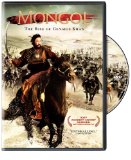| Reviews & Columns |
|
Reviews DVD TV on DVD Blu-ray 4K UHD International DVDs In Theaters Reviews by Studio Video Games Features Collector Series DVDs Easter Egg Database Interviews DVD Talk Radio Feature Articles Columns Anime Talk DVD Savant Horror DVDs The M.O.D. Squad Art House HD Talk Silent DVD
|
DVD Talk Forum |
|
|
| Resources |
|
DVD Price Search Customer Service #'s RCE Info Links |
|
Columns
|
|
|
Mongol
New Line // R // October 14, 2008
List Price: $27.98 [Buy now and save at Amazon]
Powerful and provocative, Mongol takes a resonant approach at portraying the early life of Genghis Khan -- a style that leans heavily on art-house poeticism than historical badgering. Like Mel Gibson and Ridley Scott's panache in epic history lessons swirled into early Mongolian tribal brutality, it's a singular and uncomplicated collage of images that gloriously and luridly interpret these "nebulous" years of the warlord's life. Instead of a mere hollow overview, Russian director Sergei Bodrov's insight works towards making its audience comprehend -- and even approach humanistic justification -- of Mongolia's unitary warlord on an instinctual, beautifully evocative level.
The Film:
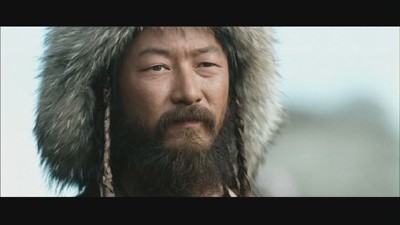
As the first installment of a projected Genghis Khan troligy, Mongol's broken up cleanly into distinct childhood / pre-Khan adulthood segments as his story starts roughly in the 1160s. In his early years, we see Temujin (spelled Temudgin in the subtitles), as the tribal leader's son, looked upon with questionable eyes as an outcast of sorts. He's labeled as such due to his mother's status as a stolen bride from the rival Merkit tribe. As the child of a woman from the Merkits, the tribesmen react unfavorably when Temujin's birthright forces him in the position of a childhood leader once his father dies due to poisoning. At the time, as stated several times in the narration and by characters in Mongol, it's a world where personal empathy and care surrender to the instinctual nature of two forces: theft, and battle. Due in large part to those factors, he and his family are eschewed into exile and Temujin surrenders his place in line.
Focus rarely sways from the entrancing glances of the young leader-to-be as Mongol pushes along in its early stages. There's an overwhelmingly beautiful shot of the boy, played by freshman child actor Odnyam Odsuren, surrounded by flurries of snow while looking up through a ridge in an epiphany-inducing moment. As he meets eyes with a slate-shaded wolf, it's as if the primal nature of Temujin unlocks in bubbling intensity. Odnyam Odsuren portrays the young Temujin with potency, a quality ever-present in all his scenes that span from his early choosing of his betrothed wife Borte, to his relationship with his "blood"-brother Jamukhwa that developed during a time of despair for the youngster -- a relationship that would spark tribal warfare as the two boys grow older and more motivated towards the status of Khan.
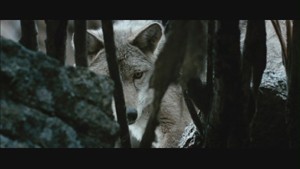
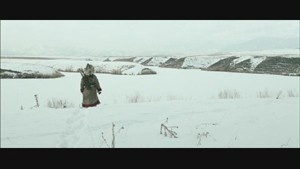
As strong as they might be, these earlier memories become mere afterthoughts once Asano Tadanobu comes on-screen as the aged Temujin in Mongol. He's offered several solid character performances over the years, working with Takeshi Kitano on his excellent Zatoichi reimagining and with Ishii Katsuhito as the spaced-out uncle in The Taste of Tea, but nothing that approaches the raw usage of core talent displayed here. He's not boisterous, fuming, disparate, or all that expressive at all, though he communicates all of the above with simple glances and facial shifts that'll surprise with their effectivenes. Asano Tadanobu's performance as he guides through these painful early years -- marred by nomad desperation, kidnap of his wife, and repeated capture and imprisonment -- is a fraught, potent exercise in raw emotionality. There's a clear goal in his performance, one that hinges heavily on communicating a transformation from this disparate man into the much-maligned warlord. Along with his lead's radiant performance and a substantial grasp on the core tone behind Temujin's love for Borte, Bodrov's historical portrait gets it all very right.
Mongol's signature asset comes in this visceral way of communicating history. Instead of verbalizing every fact in attempts at accuracy, it leaves many key aspects hidden from audience comprehension to allow for more humanizing connections with the warrior Mongol. These aren't acts of dishonesty on the filmmakers parts, but more resourceful direction-taking that leaves some of his past for interpretation. Temujin's connection with the "blue wolf", also known as the great Mongiloan god Tengri, rarely leaks into the narrative, only shown by conspicuously evocative imagery featuring the physical presence of a wolf several times in the film. Also, little word is mentioned of his impoverished time in the wilderness with his family, which leads to an event in Temujin's early life that cements some of his harsher and more destructive tendencies. These tactics mask -- even, in ways, enhance -- some of the film's embellishments, which work both as a way of simplifying the story for easier digestion and as a respectful nod in trying to humanize an oft-perceived inhuman entity. It's a careful balance between humanity, history, and cinematic beauty that Mongol handles with surprising breadth -- especially within a stark, effective visual design.
Speaking of visual composition, if you've ever wondered what the cinematography style from Bekmambetov's Night Watch and Day Watch would look like under the suppression of realism and palette control, then you'll get a glimpse here. Photographed by Sergey Trofimov, tag-teamed with Quills and Disturbia cinematographer Rogier Stoffers, Mongol's rich visual style becomes a character of its own within the effervescent narrative. At most times, it's a subdued palette that rarely treks into lurid coloring; however, when it does splash hues into its frame, they really make an impression. Trofimov's an underrated genius when it comes to non-effects driven shots, especially with close-quartered facial shots and bodily movement. He ensnares these same properties in Mongol, rendering almost achingly-beautiful close-ups. Considering the film's budget ranges somewhere underneath $20 million, it's amazing see how expansive and gloriously beautiful of a picture Sergei Bodrov created with Mongol.
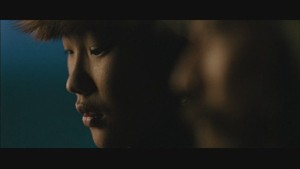
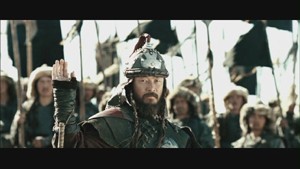
This sumptuousness echoes heavily into the vicious battle sequences as a form of concentration on the instinctual Mongolian frame of mind during Genghis Khan's time. It boils the blood of this preceding stretch of time that shapes Temujin into one of history's bloodthirsty behemoths. Amid swirling scimitar blades and scattershot droplets of blood that rival many samurai flicks, this becomes a ravishing film marked by entrancing production values that handle many different moods -- brutality, despair, even flashes of happiness. Even in the battles' afterthoughts, featuring the Mongols surrounding a campfire and humming tunes that echo all throughout the film's sweeping score, there's a distinct buzz about the entire picture that continues to engage during its somewhat peaceful scenes.
Mongol's relationship to the history of Genghis Khan harnesses the kind of potency that 300 could've embodied regarding Leonidas of Sparta and the battle of Hell's Gate, matching its veracity with wisely-scattered battle sequences that thrust the film's attitude forward with unquenchable energy. It's a polarizing epic picture, marked with the right blends of simplicity in narrative and bombast in signature action. More importantly, it's surprising how engaging Bodrov's bleak and bloody portrait of Genghis Khan turns out to be. Accuracy might not be its forte, but its smooth balance between historically-tweaked fiction and visceral entertainment spreads its absorbent nature to a broad range of audiences. As a fan of well-assembled and controlled historical epics, I carried away a profound sense of enjoyment after soaking in Mongol.
The DVD:
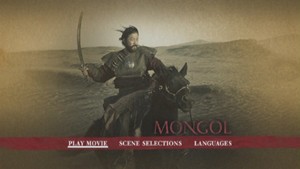
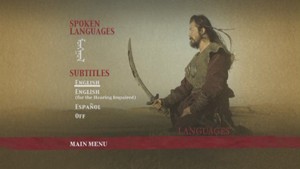
New Line / Warner Bros. has released Mongol in a standard keepcase presentation that captures the epic sense of the film's battle sequences in its attractive artwork. It's kind of neat that New Line is further transforming into Warner's foreign wing of DVD distribution, as they've done a nice job in this spectrum over the past few years.
The Video:
Mongol, as harped on earlier, is a absolutely magnificent visual experience -- which is replicated splendidly with this anamorphic 2.35:1 widescreen transfer. Cinematographers Trofimov and Stoffers play with a lot of subdued, albeit richly-toned, colors across the film, rendering blues, tans, and greens that fight for space with the range of grayish tones throughout. New Line's transfer does this visual experience a lot of justice with this finely-detailed image, an effort prominently highlighted by exquisite proficiency in sharpness and shading competency. Both dark and light scenes look quite nice, while scenes that display both spectrums in the same shot -- such as scenes featuring snow and rocky scenery -- handle the contrasting lightness well.
There's a bit of digital grain visible in several scenes, especially during the dark portions that allow stark oranges and reds to pour through due to the accompanying fire providing the light, but there's the good possibility that this might be intentional. However, all the commotion on-screen is encapsulated splendidly, from the splattering of blood and trickling of raindrops to the rustling of high-growing grass and flying of arrows. But the most impressive accomplishment of this transfer is the rendering of depth of field, which the photography team profusely played with -- especially in scenic shots. This, along with the rest of the visual treats in Mongol, all look fantastic in New Line's exquisite transfer.
The Audio:
Matching this visual treat is an equally potent Mongolian Dolby Digital 5.1 presentation. There's a blend of more subdued scenes and brash combat sequences in the film, but on a whole it's actually a rather loud sound experience. During "silent" scenes, the moans of rhythmic chanters and the rich score can be heard, both of which add sublime atmosphere to this historical epic. Considering that it's a lower-bitrate audio presentation, I was highly surprised by the range of the sound effects. The clanking of sword and graceful little effects of water trickling push the high-end of this audio presentation with surprising elasticity to higher extremes, while the lower-frequency channel gets its own workout with the gallop of horses and other assorted bumps and thuds, all of which hit moderate-to-deep lows with plenty of punch. Mongol's fantastic audio presentation does its due work in pairing with the show-stealing video. Only the Mongolian 5.1 track is available, but optional English, English SDH, and Spanish subtitles accompany it.
The Extras:
After enjoying the heck out of Mongol from start to finish, both in filmic quality and in digital production, the absolute and complete lack of supplemental features spun was a big downer. Instead of elaborating on the true history behind Genghis Khan, including referencing what parts of history actually made it into the film -- and what ones were left out completely -- we're left only with the film experience. All we've got is a Scene Selection. It's a real shame, because there's a big opportunity here for some great supplements -- even the porting of the British disc's Making-Of featurette would've been enough. Disappointing.
-----
Final Thoughts:
If you like arthouse-style composition of brutality and historical storytelling, then Mongol's something that shouldn't be missed. It takes a graceful path into Genghis Khan's erratic past that would shape him into the potent figure renowned today. There's a lot of material left inside history's black hole that we don't see of his life -- material that might tinker with the tone of the film a little bit -- but the rhythm of the film more or less treats us like we know these facts already. For a piece of semi-historical storytelling, Mongol delivers strength and emotional connections to roundabout accurate events in the figure's timeline. New Line's disc, sadly, should've at least contained a trailer or the Making-of documentary present on the U.K's disc, but this presentation of the film paired with rich visual and aural conception still earns a High Recommendation.
Thomas Spurlin, Staff Reviewer -- DVDTalk Reviews | Personal Blog/Site
The Film:

As the first installment of a projected Genghis Khan troligy, Mongol's broken up cleanly into distinct childhood / pre-Khan adulthood segments as his story starts roughly in the 1160s. In his early years, we see Temujin (spelled Temudgin in the subtitles), as the tribal leader's son, looked upon with questionable eyes as an outcast of sorts. He's labeled as such due to his mother's status as a stolen bride from the rival Merkit tribe. As the child of a woman from the Merkits, the tribesmen react unfavorably when Temujin's birthright forces him in the position of a childhood leader once his father dies due to poisoning. At the time, as stated several times in the narration and by characters in Mongol, it's a world where personal empathy and care surrender to the instinctual nature of two forces: theft, and battle. Due in large part to those factors, he and his family are eschewed into exile and Temujin surrenders his place in line.
Focus rarely sways from the entrancing glances of the young leader-to-be as Mongol pushes along in its early stages. There's an overwhelmingly beautiful shot of the boy, played by freshman child actor Odnyam Odsuren, surrounded by flurries of snow while looking up through a ridge in an epiphany-inducing moment. As he meets eyes with a slate-shaded wolf, it's as if the primal nature of Temujin unlocks in bubbling intensity. Odnyam Odsuren portrays the young Temujin with potency, a quality ever-present in all his scenes that span from his early choosing of his betrothed wife Borte, to his relationship with his "blood"-brother Jamukhwa that developed during a time of despair for the youngster -- a relationship that would spark tribal warfare as the two boys grow older and more motivated towards the status of Khan.


As strong as they might be, these earlier memories become mere afterthoughts once Asano Tadanobu comes on-screen as the aged Temujin in Mongol. He's offered several solid character performances over the years, working with Takeshi Kitano on his excellent Zatoichi reimagining and with Ishii Katsuhito as the spaced-out uncle in The Taste of Tea, but nothing that approaches the raw usage of core talent displayed here. He's not boisterous, fuming, disparate, or all that expressive at all, though he communicates all of the above with simple glances and facial shifts that'll surprise with their effectivenes. Asano Tadanobu's performance as he guides through these painful early years -- marred by nomad desperation, kidnap of his wife, and repeated capture and imprisonment -- is a fraught, potent exercise in raw emotionality. There's a clear goal in his performance, one that hinges heavily on communicating a transformation from this disparate man into the much-maligned warlord. Along with his lead's radiant performance and a substantial grasp on the core tone behind Temujin's love for Borte, Bodrov's historical portrait gets it all very right.
Mongol's signature asset comes in this visceral way of communicating history. Instead of verbalizing every fact in attempts at accuracy, it leaves many key aspects hidden from audience comprehension to allow for more humanizing connections with the warrior Mongol. These aren't acts of dishonesty on the filmmakers parts, but more resourceful direction-taking that leaves some of his past for interpretation. Temujin's connection with the "blue wolf", also known as the great Mongiloan god Tengri, rarely leaks into the narrative, only shown by conspicuously evocative imagery featuring the physical presence of a wolf several times in the film. Also, little word is mentioned of his impoverished time in the wilderness with his family, which leads to an event in Temujin's early life that cements some of his harsher and more destructive tendencies. These tactics mask -- even, in ways, enhance -- some of the film's embellishments, which work both as a way of simplifying the story for easier digestion and as a respectful nod in trying to humanize an oft-perceived inhuman entity. It's a careful balance between humanity, history, and cinematic beauty that Mongol handles with surprising breadth -- especially within a stark, effective visual design.
Speaking of visual composition, if you've ever wondered what the cinematography style from Bekmambetov's Night Watch and Day Watch would look like under the suppression of realism and palette control, then you'll get a glimpse here. Photographed by Sergey Trofimov, tag-teamed with Quills and Disturbia cinematographer Rogier Stoffers, Mongol's rich visual style becomes a character of its own within the effervescent narrative. At most times, it's a subdued palette that rarely treks into lurid coloring; however, when it does splash hues into its frame, they really make an impression. Trofimov's an underrated genius when it comes to non-effects driven shots, especially with close-quartered facial shots and bodily movement. He ensnares these same properties in Mongol, rendering almost achingly-beautiful close-ups. Considering the film's budget ranges somewhere underneath $20 million, it's amazing see how expansive and gloriously beautiful of a picture Sergei Bodrov created with Mongol.


This sumptuousness echoes heavily into the vicious battle sequences as a form of concentration on the instinctual Mongolian frame of mind during Genghis Khan's time. It boils the blood of this preceding stretch of time that shapes Temujin into one of history's bloodthirsty behemoths. Amid swirling scimitar blades and scattershot droplets of blood that rival many samurai flicks, this becomes a ravishing film marked by entrancing production values that handle many different moods -- brutality, despair, even flashes of happiness. Even in the battles' afterthoughts, featuring the Mongols surrounding a campfire and humming tunes that echo all throughout the film's sweeping score, there's a distinct buzz about the entire picture that continues to engage during its somewhat peaceful scenes.
Mongol's relationship to the history of Genghis Khan harnesses the kind of potency that 300 could've embodied regarding Leonidas of Sparta and the battle of Hell's Gate, matching its veracity with wisely-scattered battle sequences that thrust the film's attitude forward with unquenchable energy. It's a polarizing epic picture, marked with the right blends of simplicity in narrative and bombast in signature action. More importantly, it's surprising how engaging Bodrov's bleak and bloody portrait of Genghis Khan turns out to be. Accuracy might not be its forte, but its smooth balance between historically-tweaked fiction and visceral entertainment spreads its absorbent nature to a broad range of audiences. As a fan of well-assembled and controlled historical epics, I carried away a profound sense of enjoyment after soaking in Mongol.
The DVD:


New Line / Warner Bros. has released Mongol in a standard keepcase presentation that captures the epic sense of the film's battle sequences in its attractive artwork. It's kind of neat that New Line is further transforming into Warner's foreign wing of DVD distribution, as they've done a nice job in this spectrum over the past few years.
The Video:
Mongol, as harped on earlier, is a absolutely magnificent visual experience -- which is replicated splendidly with this anamorphic 2.35:1 widescreen transfer. Cinematographers Trofimov and Stoffers play with a lot of subdued, albeit richly-toned, colors across the film, rendering blues, tans, and greens that fight for space with the range of grayish tones throughout. New Line's transfer does this visual experience a lot of justice with this finely-detailed image, an effort prominently highlighted by exquisite proficiency in sharpness and shading competency. Both dark and light scenes look quite nice, while scenes that display both spectrums in the same shot -- such as scenes featuring snow and rocky scenery -- handle the contrasting lightness well.
There's a bit of digital grain visible in several scenes, especially during the dark portions that allow stark oranges and reds to pour through due to the accompanying fire providing the light, but there's the good possibility that this might be intentional. However, all the commotion on-screen is encapsulated splendidly, from the splattering of blood and trickling of raindrops to the rustling of high-growing grass and flying of arrows. But the most impressive accomplishment of this transfer is the rendering of depth of field, which the photography team profusely played with -- especially in scenic shots. This, along with the rest of the visual treats in Mongol, all look fantastic in New Line's exquisite transfer.
The Audio:
Matching this visual treat is an equally potent Mongolian Dolby Digital 5.1 presentation. There's a blend of more subdued scenes and brash combat sequences in the film, but on a whole it's actually a rather loud sound experience. During "silent" scenes, the moans of rhythmic chanters and the rich score can be heard, both of which add sublime atmosphere to this historical epic. Considering that it's a lower-bitrate audio presentation, I was highly surprised by the range of the sound effects. The clanking of sword and graceful little effects of water trickling push the high-end of this audio presentation with surprising elasticity to higher extremes, while the lower-frequency channel gets its own workout with the gallop of horses and other assorted bumps and thuds, all of which hit moderate-to-deep lows with plenty of punch. Mongol's fantastic audio presentation does its due work in pairing with the show-stealing video. Only the Mongolian 5.1 track is available, but optional English, English SDH, and Spanish subtitles accompany it.
The Extras:
After enjoying the heck out of Mongol from start to finish, both in filmic quality and in digital production, the absolute and complete lack of supplemental features spun was a big downer. Instead of elaborating on the true history behind Genghis Khan, including referencing what parts of history actually made it into the film -- and what ones were left out completely -- we're left only with the film experience. All we've got is a Scene Selection. It's a real shame, because there's a big opportunity here for some great supplements -- even the porting of the British disc's Making-Of featurette would've been enough. Disappointing.
-----
Final Thoughts:
If you like arthouse-style composition of brutality and historical storytelling, then Mongol's something that shouldn't be missed. It takes a graceful path into Genghis Khan's erratic past that would shape him into the potent figure renowned today. There's a lot of material left inside history's black hole that we don't see of his life -- material that might tinker with the tone of the film a little bit -- but the rhythm of the film more or less treats us like we know these facts already. For a piece of semi-historical storytelling, Mongol delivers strength and emotional connections to roundabout accurate events in the figure's timeline. New Line's disc, sadly, should've at least contained a trailer or the Making-of documentary present on the U.K's disc, but this presentation of the film paired with rich visual and aural conception still earns a High Recommendation.
|
| Popular Reviews |
| Sponsored Links |
|
|
| Sponsored Links |
|
|
| Release List | Reviews | Shop | Newsletter | Forum | DVD Giveaways | Blu-Ray | Advertise |
|
Copyright 2024 DVDTalk.com All Rights Reserved. Legal Info, Privacy Policy, Terms of Use,
Manage Preferences,
Your Privacy Choices | |||||||









